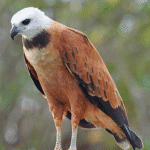

The Zo’é are a small, isolated tribe living deep in the Amazon rainforests of north Brazil. They only came into sustained contact with outsiders in 1987 when missionaries of the New Tribes Mission built a base on their land.
Their land has been officially recognized by the government, which controls access to it to minimise the transmission of potentially fatal diseases such as flu and measles.
The Zo’é live in large rectangular thatched houses which are open on all sides. Here several families live together, sleeping in hammocks slung from the rafters and cooking over open fires along the sides.
The Zo’é prize Brazil nuts, and often site their communities in groves of Brazil nut trees. As well as providing a rich source of food, the nut shells are fashioned into bracelets, and the shell fibre is used to make hammocks.
Zo’é communities are surrounded by large gardens where manioc and other tubers, peppers, bananas and many other fruits and vegetables are grown. Cotton is cultivated and used to make body ornaments and hammocks, to bind arrow heads and to weave slings for carrying babies.
The Zo’é are polygamous, and both men and women may have more than one partner. It is fairly common for a woman with several daughters to marry several men, some of whom may later marry one of her daughters.
Everyone is equal in Zo’é society. There are no leaders, though the opinions of particularly articulate men, known as ‘yü’, carry more weight than others in questions of marriage, opening up old gardens or establishing new communities.
The men are extremely skilled hunters. Hunting is usually done individually, but at certain times of the year – ‘fat monkey time’ or ‘king vulture time’ – collective hunts are organised.
When large bands of peccaries mass together Zo’é men hunt together, running furiously after the peccaries firing arrows, while the women catch the startled babies, which are taken back home and raised as pets or ‘raimbé’. The Zo’é also fish using harpoons and timbó – a fish poison made from crushed vines.

From a young age all Zo’é wear the ‘m’berpót’ – the long wooden plug inserted into the lower lip.
Zo’é children have their lower lip pierced at around 7 to 9 years old; larger plugs are inserted as they grow older.
The Zo’é tell how an ancestor called Sihié’abyr showed them how to use the lip plug. One of the most important ceremonies, and a rite of passage for children, is the piercing of the lower lip.
A sharp bone from a spider monkey’s leg is used, and a tiny ‘m’berpót’ is inserted, usually when girls are about seven and boys about nine years old. As they grow older, larger plugs are inserted.
Women wear elaborate headdresses made from the soft white breast feathers of the king vulture, and paint their bodies with urucum – a vibrant red paste made from crushing annatto seeds.
Like many trible peoples of South America, the Zo’é use annatto paste to paint their bodies and faces.
Rituals mark many aspects of Zo’é life such as birth and death, girls’ first menstruation, and the first tapir hunted by adolescent boys.
Seh’py is perhaps the greatest collective ceremony, which can be performed to mark any important event. It is named after the naturally fermented drink served during the ritual, which is made from any tuber in season at the time. The men dress in long fibre skirts called ‘sy’pi’. Men and women dance together all night in a series of unique dances accompanied by singing. At dawn the men finish the drink and expel it by vomiting together.
















Site Desenvolvido por: 🚀 Agência Digital HGX Criação de Sites e Marketing Digital Criação de Sites e Marketing Digital
Obrigado pelo seu contato, retornaremos em breve! Thank you for contacting us, we will get back to you shortly!
Inscreva-se na minha newsletter para ver novas fotos, dicas e postagens do blog.